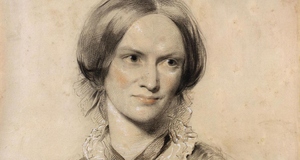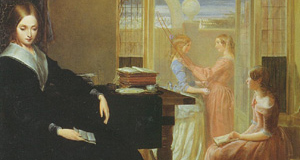Featured Article:Trauma Reenactment in the Gothic Loop: A Study on Structures of Circularity in Gothic Fiction
By
2014, Vol. 6 No. 05 | pg. 4/4 | « The Return of History in Butler’s KindredOctavia E. Butler’s novel titled Kindred was first published in 1979, and it is a tale that places the notion of time travel into an African-American historical and supernatural context. While many other stories by Butler rely on science fiction as an underlying genre, in case of Kindred time travel occurs without any scientific explanation, so that its presence is suggested to be a supernatural phenomenon rather than a result of some futuristic innovation. The narrative is centered around its present-day black protagonist, Dana, who is forced to re-experience the lives of African-American slaves during the antebellum period as she is repeatedly pulled back to the American past by some inexplicable supernatural force. Travelling in time is not a choice she makes; rather, it is imposed upon her by the bond that exists between her and Rufus Weylin, son of a white plantation owner, who is revealed to be one of her ancestors. Whenever Rufus is in need of help, Dana is drawn back to a historical era when and where she is immediately identified as a slave and is treated accordingly. Later on, Dana’s white husband called Kevin also joins her in her exploration of antebellum history, and the journey they share probes their present-day relationship as well. The number of Dana’s time travels grows as the narrative progresses, and with each journey she spends more time back in the past. After several time travels she realizes that she no longer feels present in her real present as the past begins to transform her identity, also separating her from her husband whose vision of history differs, to a great extent, from Dana’s due to his different social status as a white man. Eventually the past becomes so strong that Dana finds it almost impossible to return, and although she manages to escape from her own family history, she loses an arm which merges into a wall during her last travel. This last accident, foreshadowed by the prologue of the novel, leaves a lifetime mark on her, a constant physical reminder of the antebellum years.Already from the structure of the narrative it becomes clear that Kindred works extensively with the kind of Gothic loop described in this study. The novel uses the notion of time travel to achieve a literal, unwanted and compulsively repeated return to the past. Structurally, the novel is arranged as one gigantic loop as it starts out with a prologue that actually reveals the end of the tale. Thus, Kindred ends exactly where it begins, and its plotline creates a sense of circularity of historical events. The chapters themselves are presented as stages in Dana’s journey, during which she is travelling both inward towards an examination of her identity and outward towards her family history, but they also carry an atmosphere of repetition due to the similarity of the conflicts they project. As Christine Levecq notes, “the titles of the chapters (…) evoke through their parallelism the idea of repeated confrontations with an all-encompassing force presenting itself under slightly different guises” (532). Therefore, the stages presented by Butler’s novel are not purely stages, but “waves of the same endlessly recurring conflict” (Levecq 532) whose presence can be felt not only in the historical past, but in Dana’s present as well. That is where the notion of that ever-present trauma described by Massé’s analysis emerges in the form of constant Gothic loops in Butler’s Kindred, except that in this case, temporal repetition works in order to reveal not only the social trauma of oppressed femininity, but also that of African-American identity and history. With the disappearance of the boundaries of past and present, Kindred shows how certain conflicts repressed by society and falsely believed to be resolved are actually still very much alive in Butler’s present-day American society, and how, by forcing oneself back to the past, these can easily be brought to the surface. David LaCroix also recognizes that tendency in the novel when he states that Kindred “dramatizes the overlapping oppressions all too common to the experience of black American women” by establishing an “unstable and even threatening relationship between contemporary individuals and prior versions of the world” (LaCroix 109-111). Similarly to ghost stories where the protagonist is forced to return to certain past traumas in order to ensure his or her own progression, in case of Kindred the main character, chosen by some blind, grim fate, is required to face the traumatic reality of slavery and racism that characterized the antebellum years in order to reassure her own present existence. In Kindred the task of resolving a particular past matter works with what one could call ‘belated blaming,’ in the sense that it is assigned to a character whose present is completely detached from the time of the original event and who thus cannot, directly, be held responsible for the initial situation. This device is also often used by ghost stories in which protagonists inherit past traumas that seemingly have little to do with their lives. Yet, as the tale of Kindred progresses, one finds that Dana’s present-day life shares a number of features with her past, so that her status of being the ‘chosen one’ is slowly revealed to be not simply a coincidence, but rather a very conscious, preordained decision. As the tale evolves, Dana’s stays in the past become longer and more difficult in terms of the challenges that they offer, which exemplifies how recurrent Gothic loops tend to tighten and transform with each repetition. The greatest loop of the narrative is Dana’s own identity, which needs to be saved before it would be erased from history. However, while doing so, she also has to accept the risk of dying in her own ancestral past, taking on an identity that could have been hers, had she been born back then. This threat of being swallowed by one’s ancestral past also holds the risk that Dana’s future (and not only her present) will similarly be possessed by the history she comes from. The promise of any revised future can only be granted if Dana manages to resolve all the past events that haunt her identity. On a personal level, these events are related to her direct ancestry line, while on an extended level they suggest the pervasive trauma of black identity in American history. In the end, Dana is given no other choice but to return and support her ancestors in a cyclical, repetitive manner until her past (and her present) is secured. While doing so, she not only has to accept the past as it happened, resisting the urge to change certain events in history, but she also has to consider her present-day position in society in terms of her rights and possibilities as an African-American woman. Just like in case of other Gothic loops, the future is outside of the frame of the narrative and is only signaled by Dana’s present decisions in the same way as Dana’s present is shown to be a direct result of certain past events. Butler’s novel works with an extremely active way of remembering where the past literally comes alive in order to present a lesson to the contemporary present. This literary tendency that has been referred to as “exorcising the past” (Wood 83) or “raising the dead” (LaCroix 112) is often characteristic of the American Gothic tradition (one notable example could be Toni Morrison’s Beloved) and it is a highly suitable form of trauma reenactment and collective remembrance. This technique is able to transform the past—frequently thought of as something distant and closed—into a relevant, modern reality whose prevailing influence on society can be identified. Rushdy in a study on Butler’s novel claims that “Dana’s act of memory (…) is a performance of history, a performance of such potency that it incorporates her into the past, leaving “no distance at all” between her and the remembered events” (Rushdy 137-138). Such a powerful form of remembering can only be possible in a somewhat fictional, hypothetical site, such as the one provided by the Gothic loop, where the past can gain control over, as well as legitimacy within, the present. In Kindred the era of slavery returns, but not in order to repeat itself; rather it interferes in order to help the present, seen as a collective state, acquire a different perspective on its own ancestry. That influence of the past on the present becomes especially crucial in case of cultural identities or social groups whose view of history has, for a long time, been suppressed by society in favor of another, more dominant historical narrative. Sarah Wood confirms that in Butler’s novel, “Dana’s journeys into the past expose how, even in the wake of the black protest movements of the 1950s and 1960s, the hidden histories and experience of slavery throw into question the grounds upon which a contemporary black woman is able to construct her sense of self” (Wood 85). Further ConsiderationsGothic temporal loops play a key part in the genre’s endeavors to establish literary sites of trauma reenactment. Whether trauma is understood as an ever-present state originating from one’s oppressed identity or as a traumatic past event with certain post-effects, Gothic literature aims at capturing it with the technique of confusing the timeline of the narrative. The aim of such a temporal confusion is to evoke a disturbing sense of backward-pointing progress, one which allows for a reconsideration as well as a resolution of the past. Butler’s Kindred, similarly to other novels born out of the same attempt to examine history in an exploration of social and cultural progress, is one example of a successful reliance on the structural form of the Gothic loop which, with its critical and reevaluating tendencies, calls for a revision of history and, consequently, that of the present as well. At the end of her paper Massé refers to an idea echoed by many scholars of the Gothic, regarding the possibility to bring the genre (or mode) of literary Gothic to an end (Massé 709). What she claims is the strong belief that as long as pervading collective traumas, such as those having to do with cultural or social identity, are preserved in society, the Gothic as a literary genre will remain a relevant form of cultural warning, repeatedly and compulsively pointing towards its literary revisions of traumatic events until they are finally resolved. As Steven Bruhm explains, “the Gothic continually confronts us with real, historical traumas that we in the west have created but that also continue to control how we think about ourselves as a nation” (Bruhm 271). While repetition within the Gothic is often claimed to be a disadvantageous, shallow feature of the genre, it is in fact a structural aspect carrying a surprisingly strong potential. Repetition in the Gothic suggests not a lack of imagination or an inclination toward a set of clichés; rather what it points to is the significance of making visible certain cultural phenomena—historical traumas, identities on the social margins—that society constantly and repeatedly represses and which the Gothic mode, with its experimental sites provided by the structure of loops, can effectively and powerfully bring to public attention. ReferencesBerthin, Christine. Gothic Hauntings. Melancholy Crypts and Textual Ghosts. London: Palgrave Macmillan, 2010 Bruhm, Steven. “The Contemporary Gothic: Why We Need It.” In. The Cambridge Companion to Gothic Fiction. Jerrold E. Hogle. (ed.). Cambridge: Cambridge University Press, 2002 Cavallaro, Dani. The Gothic Vision. Three Centuries of Horror, Terror and Fear. London: Continuum, 2002 DeLamotte, Eugenia C. Perils of the Night. A Feminist Study of Nineteenth-Century Gothic. Oxford: Oxford University Press, 1990 Edwards, Justin D. Gothic Passages: Racial Ambiguity and the American Gothic. Iowa City: University of Iowa Press, 2003 LaCroix, David. “To Touch Solid Evidence: The Implicity of Past and Present in Octavia E. Butler’s ‘Kindred’.” In. The Journal of the Midwest Modern Language Association. Vol. 40, No. 1. Midwest Modern Language Association, 2007 Levecq, Christine. “Philosophies of (Literary) History in Octavia E. Butler’s ‘Kindred’.” In. Contemporary Literature. Vol. 41, No. 3. University of Wisconsin Press, 2000 Massé, Michelle A. “Gothic Repetition: Husbands, Horrors and Things That Go Bump In the Night.” In. Signs: Journal of Women In Culture and Society. Vol. 15, No. 4. 1990 Morris, David B. “Gothic Sublimity.” In. New Literary History. Vol. 16, No. 2. The John Hopkins University Press, 1985 Morrison, Toni. Beloved. New York: Penguin Group, 1998 Punter, David. Glennis Byron. The Gothic. Oxford: Blackwell Publishing, 2004 Spooner, Catherine. Contemporary Gothic. London: Reaktion Books, 2006 Wood, Sarah. “Exorcizing the Past: The Slave Narrative as Historical Fantasy.” In. Feminist Review. No. 85, Political Hystories. Palgrave Macmillan Journals. 2007 Suggested Reading from Inquiries Journal
Inquiries Journal provides undergraduate and graduate students around the world a platform for the wide dissemination of academic work over a range of core disciplines. Representing the work of students from hundreds of institutions around the globe, Inquiries Journal's large database of academic articles is completely free. Learn more | Blog | Submit Latest in Literature |


















